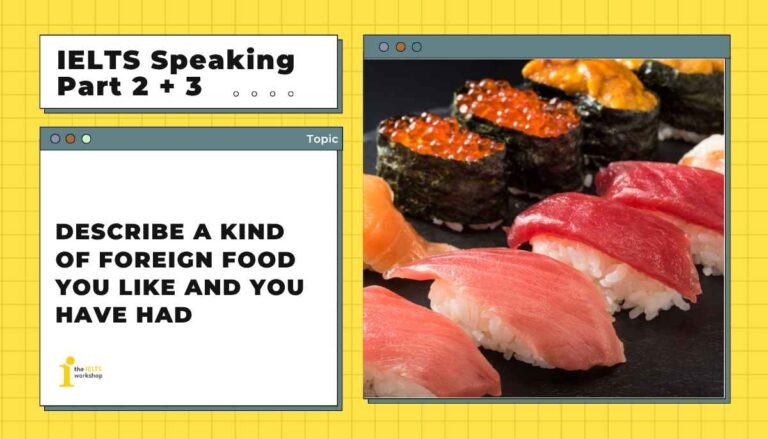Chủ đề Describe a kind of foreign food you like and you have had thường xuất hiện trong IELTS Speaking Part 2, đòi hỏi người học kể lại trải nghiệm ẩm thực với một món ăn nước ngoài mà bản thân yêu thích. Trong bài mẫu dưới đây, cô Ngô Thị Thu Thủy lựa chọn món sushi – một đại diện nổi bật của ẩm thực Nhật Bản, không chỉ gây ấn tượng bởi hương vị tươi ngon mà còn bởi giá trị văn hóa sâu sắc đằng sau từng miếng ăn tinh tế
Part 2: Describe a kind of foreign food you like and you have had
You should say:
- What it is
- When and where you had it
- Why you like it
- And explain how you feel about it
1. Bài mẫu (Sample)
When it comes to foreign food, the first thing that springs to mind is sushi – an iconic dish from Japan that has become popular all over the world. I’d heard about sushi for years through books, TV programs, and even social media, but I never had the opportunity to try it until after I graduated from university. To celebrate my new job, my colleagues – who are true foodies – invited me to a high-end Japanese restaurant called Ishushi. That was the very first time I got to taste authentic sushi.
What struck me instantly was the visual presentation. Each piece was like a miniature work of art, with vibrant colors from fresh ingredients like tuna, salmon, shrimp, and herring. The fish was placed delicately on top of seasoned rice, often with a touch of wasabi underneath. As soon as I took my first bite, I was blown away. The freshness of the seafood combined with the subtle tang of rice and soy sauce created a perfect balance of flavors. It was light yet deeply satisfying – a taste I had never experienced before.
Since then, sushi has become one of my go-to choices for special occasions, like birthdays or celebratory dinners. Not only do I enjoy the flavor, but I also appreciate the cultural significance and craftsmanship behind it. It’s more than just food – it’s a culinary experience.
Sample band 8.0 by Ngo Thi Thu Thuy, IELTS Teacher at The IELTS Workshop
2. Từ vựng (Vocabulary)
- springs to mind: xuất hiện trong đầu ngay lập tức
- iconic dish: món ăn biểu tượng
- foodie: người sành ăn, yêu ẩm thực
- high-end: cao cấp, đắt tiền
- authentic: chính gốc, đích thực
- struck (me): gây ấn tượng mạnh
- visual presentation: cách trình bày hình ảnh (món ăn)
- miniature work of art: tác phẩm nghệ thuật thu nhỏ
- vibrant colors: màu sắc sống động
- delicately: một cách tinh tế, nhẹ nhàng
- blown away: bị choáng ngợp, ấn tượng mạnh
- freshness: độ tươi
- subtle tang: vị chua nhẹ, tinh tế
- balance of flavors: sự cân bằng về hương vị
- go-to choice: lựa chọn ưu tiên, thường xuyên
- cultural significance: ý nghĩa văn hóa
- craftsmanship: sự khéo léo, tinh xảo trong cách làm
- culinary experience: trải nghiệm ẩm thực
Xem thêm: Nắm trọn bộ từ vựng chủ đề Food + Collocations và idiom phổ biến
Part 3:
1. What’s the difference between Vietnamese food and Western food?
I think the main difference is in the ingredients and the way food is cooked. Vietnamese food is usually light, fresh, and healthy. We use lots of vegetables, herbs like mint or basil, and fish sauce for seasoning. Most dishes are boiled or steamed, not fried. On the other hand, Western food often includes cheese, butter, and cream, which makes it heavier. They also eat more meat and bread, while we eat rice or noodles with almost every meal.
- seasoning: gia vị
- boiled / steamed: luộc / hấp
- heavier: nặng hơn
2. Is it expensive to eat out in your country?
In general, eating out in Vietnam is quite affordable. There are many street food stalls and local restaurants where you can get a delicious meal for a low price. Even students or workers can eat out every day without spending too much. However, if you go to luxury restaurants or places that serve foreign food, the prices can be quite high. So it really depends on where you eat and what you order.
- affordable: giá cả phải chăng
- luxury restaurant: nhà hàng sang trọng
- foreign food: món ăn nước ngoài
3. Do you like to cook at home?
Yes, I do enjoy cooking, especially on the weekends when I have more free time. I think cooking at home is not only healthier but also more relaxing. It gives me a chance to try new recipes and control what I eat. Sometimes I cook Vietnamese dishes like pho or fried rice, but I also like trying easy foreign dishes like pasta or pancakes. During busy weekdays, though, I usually keep it simple.
- healthier: lành mạnh hơn
- recipe: công thức nấu ăn
- easy foreign dishes: món nước ngoài dễ làm
- busy weekdays: ngày trong tuần bận rộn
4. What kinds of foreign food are popular in your country?
A lot of people in Vietnam, especially young people, really enjoy Japanese food like sushi, sashimi, and ramen. Korean food is also very popular, thanks to Korean dramas and music. Dishes like kimchi, tteokbokki, and Korean fried chicken are easy to find. Besides that, Western fast food like burgers, pizza, and fried chicken is also common, especially in big cities. Even though foreign food is growing, many people still prefer Vietnamese food in daily life.
- fast food: thức ăn nhanh
- foreign food: món ăn nước ngoài
5. Do most people like to eat the food they are familiar with or try new food?
I think it depends on the person, but many people feel more comfortable with the food they know well. It reminds them of home and childhood. However, more and more people, especially the younger generation, enjoy exploring new dishes from other countries. They like to explore new flavors and learn about different cultures through food. So, I would say both are true—some prefer traditional food, while others are more adventurous.
- reminds them of home: gợi nhớ về quê nhà
- younger generation: thế hệ trẻ
- explore: khám phá
- traditional food: món ăn truyền thống
- adventurous: thích phiêu lưu / thử cái mới
Sample band 7.0 – 8.0 by Ngo Thi Thu Thuy, IELTS Teacher at The IELTS Workshop
Từ vựng mở rộng theo chủ đề
- savory: mặn, đậm đà (trái ngược với món ngọt)
- umami: vị ngọt thịt, vị đậm tự nhiên (vị cơ bản thứ 5)
- fusion cuisine: ẩm thực kết hợp (pha trộn từ nhiều nền văn hóa ẩm thực)
- palate: khẩu vị, sở thích ăn uống
- comfort food: món ăn thân thuộc, mang lại cảm giác ấm áp
- seasonal ingredients: nguyên liệu theo mùa
- mouthwatering: trông ngon chảy nước miếng
- home-cooked meal: bữa ăn nấu tại nhà
- street food: món ăn đường phố
- flavor profile: đặc trưng hương vị (của món ăn)
Xem thêm: Tổng hợp bộ từ vựng tiếng Anh về chủ đề Quần áo (Clothes)
Tạm kết
Mong rằng bài mẫu trên đã giúp bạn nắm được cách trả lời hiệu quả và sử dụng ngôn từ sinh động cho chủ đề Describe a kind of foreign food you like and you have had trong IELTS Speaking Part 2 & 3.
Tham khảo luyện tập thêm nhiều chủ đề khác, đồng thời tham khảo các tài liệu hữu ích như KHO BÀI MẪU IELTS SPEAKING và Bộ đề dự đoán IELTS Speaking 2025
Học ngay HỌC IELTS MIỄN PHÍ cùng các giáo viên tại The IELTS Workshop – đăng ký ngay hôm nay nhé!









